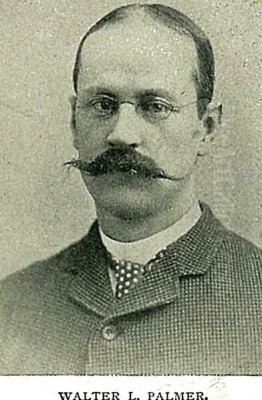
Walter Launt Palmer stands as a significant figure in American art history, celebrated particularly for his evocative and luminous depictions of winter landscapes. An artist whose career bridged the late 19th and early 20th centuries, Palmer skillfully blended elements of academic tradition, Impressionist sensibility, and a unique personal vision to capture the subtle beauties of nature, especially the transformative effects of snow and light. Born into an artistic family and nurtured within a vibrant cultural milieu, Palmer developed a distinctive style that earned him considerable acclaim during his lifetime and continues to resonate with audiences today. His life and work offer a fascinating window into the evolution of American landscape painting during a period of dynamic change.
Early Life and Artistic Beginnings in Albany
Walter Launt Palmer was born on August 1, 1854, in Albany, New York. His upbringing was steeped in art, as his father was the renowned neoclassical sculptor Erastus Dow Palmer, one of the most prominent American sculptors of his generation. The Palmer household was a hub for artists and intellectuals, providing young Walter with an environment rich in creative stimulation from his earliest years. Visitors to the family home included leading figures of the Hudson River School and other prominent artists, such as the landscape painter Frederic Edwin Church, John Kensett, and Jervis McEntee. This early exposure undoubtedly shaped his artistic inclinations.
His formal artistic training began locally. Initially, he studied portraiture, perhaps briefly, under Charles Loring Elliott, a noted portrait painter. However, his true passion lay in landscape painting. Recognizing this, his father arranged for him to study with Frederic Edwin Church, a family friend and a towering figure in American landscape art, known for his dramatic and detailed panoramic views. Studying with Church, likely around 1870-1872, provided Palmer with a strong foundation in drawing, composition, and the close observation of nature, hallmarks of the Hudson River School tradition.
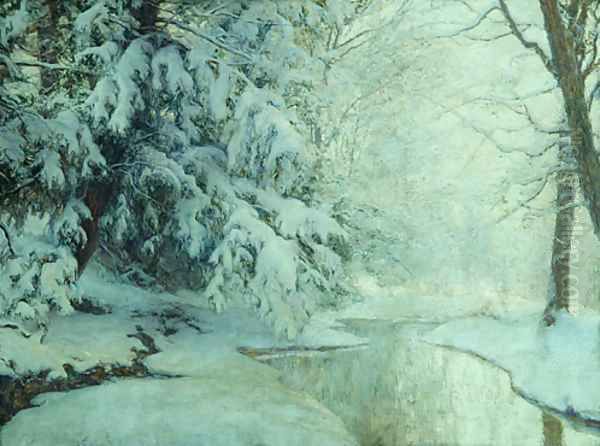
Palmer quickly showed promise, and his work was first accepted for exhibition at the prestigious National Academy of Design in New York City in 1872, when he was still a teenager. This early recognition marked the official beginning of a long and productive career, setting the stage for further development and exploration. His Albany roots remained important throughout his life, providing both a home base and frequent subject matter for his art.
European Studies and Broadening Horizons
Like many ambitious American artists of his time, Palmer sought advanced training and exposure to the European art scene. In 1873, he embarked on the first of several trips abroad, traveling to Europe with his family. This journey proved pivotal. In Paris, he enrolled in the atelier of Emile Auguste Carolus-Duran, a highly respected portraitist and figure painter whose Tonalist style and emphasis on painterly brushwork offered a contrast to the tighter rendering Palmer might have learned from Church. Carolus-Duran's studio was a magnet for international students, including another young American who would achieve global fame: John Singer Sargent. The interaction with Sargent and the broader Parisian art world exposed Palmer to contemporary trends, including the burgeoning Impressionist movement.
His European travels were not confined to Paris. Palmer spent considerable time in Italy, particularly Venice, a city that captivated countless artists with its unique light, architecture, and waterways. He produced numerous paintings and watercolors of Venetian scenes, demonstrating his growing facility with capturing atmosphere and reflection. These works often show a brighter palette and looser handling than his earliest landscapes. He also traveled elsewhere in Europe and possibly even visited Japan, absorbing diverse visual influences. These experiences broadened his artistic vocabulary and encouraged experimentation.
Subsequent trips to Europe followed, allowing him to reconnect with artists like Sargent and Robert Blum, and further immerse himself in the continent's artistic currents. He studied the Old Masters, observed contemporary exhibitions, and continued to refine his technique. The combination of his American landscape training and his European experiences laid the groundwork for the mature style he would develop upon his return to the United States.
The Emergence of a Signature Style: The Winter Landscapes
While Palmer painted various subjects throughout his career, including European scenes, interiors, and landscapes in other seasons, he became most famous for his winter landscapes, particularly his snow scenes. He began to focus seriously on this subject matter around the mid-1880s, and it would become his defining contribution to American art. Living in Albany provided ample opportunity to observe the winter environment firsthand.
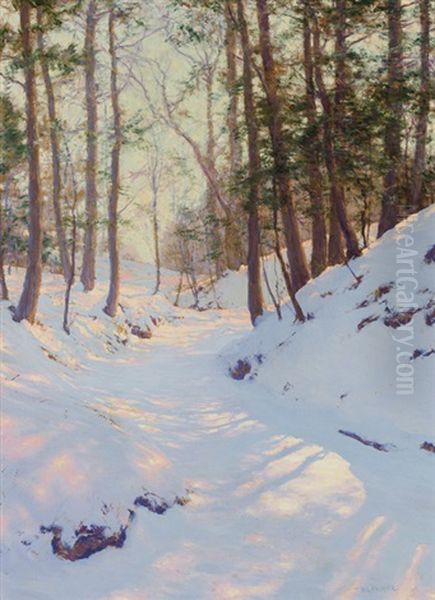
Palmer's approach to snow was revolutionary for its time in American art. He moved beyond the simple depiction of white expanses, recognizing snow as a complex surface that reflected and refracted light in myriad ways. He became a master of rendering the subtle nuances of color found in snow, particularly in shadows and under different lighting conditions – dawn, dusk, bright sunlight, overcast skies. His snow shadows are often infused with delicate blues, violets, pinks, and lavenders, capturing the cool, ambient light with remarkable sensitivity.
His technique combined meticulous observation, reminiscent of his Hudson River School training, with the looser brushwork and heightened color sense associated with Impressionism. He often worked in both oil and watercolor, sometimes incorporating gouache for opaque highlights, achieving remarkable effects of texture and luminosity. Palmer wasn't strictly an Impressionist in the French mold; his work often retained a greater degree of structure and realism. However, his fascination with capturing the transient effects of light and atmosphere, his use of broken color, and his focus on contemporary landscape subjects firmly place him within the sphere of American Impressionism.
Masterworks and Artistic Techniques
Several paintings exemplify Palmer's mastery of the winter landscape. Silent Dawn, now in the collection of the Metropolitan Museum of Art, is one of his most celebrated works. It depicts a tranquil, snow-covered stream at sunrise, the early light casting a warm glow on the upper branches of trees while the snow below remains in cool shadow, rendered with his characteristic subtle blues and pinks. The painting evokes a sense of stillness and pristine beauty. Another notable work, Winter Glow, similarly captures the ephemeral effects of light on a snowy landscape, showcasing his ability to convey both the coldness of winter and the warmth of sunlight.
Palmer's technical skill was considerable. In his oil paintings, he often built up surfaces with layers of paint, sometimes using impasto to suggest the texture of snow or tree bark, while employing smoother passages for water or sky. His watercolors are equally accomplished, demonstrating a fluid control of the medium combined with precise detail where needed. He frequently used the white of the paper itself to represent the brightest highlights on the snow, a classic watercolor technique.
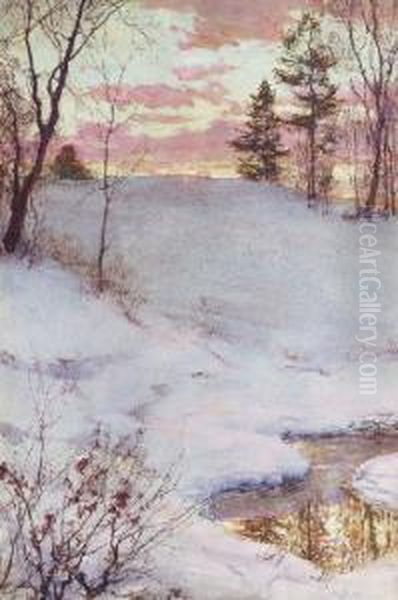
Beyond winter scenes, his Venetian works, such as views of the Grand Canal or quiet side canals, reveal his skill in depicting water reflections and architectural detail, often bathed in the distinctive Venetian light. He also painted interiors, sometimes featuring intricate details of furniture and decorative objects, showing a versatility that extended beyond landscape. Regardless of the subject, Palmer's work is consistently characterized by careful composition, sensitivity to light and color, and a refined aesthetic sensibility, possibly reflecting the "Oriental refinement" some critics noted, perhaps an echo of the era's Japonisme or simply his own delicate touch.
Professional Life: Exhibitions, Affiliations, and Recognition
Walter Launt Palmer was an active participant in the American art world throughout his career. He exhibited regularly and widely, building a significant reputation. His affiliation with the National Academy of Design was long-standing; after his debut in 1872, he was elected an Associate (ANA) in 1887 and a full Academician (NA) in 1897, prestigious honors that cemented his standing among his peers. He frequently showed work at the Academy's annual exhibitions.
He was also deeply involved with watercolor societies, reflecting his proficiency in that medium. He was a member of the American Watercolor Society and the New York Water Color Club, exhibiting often with both organizations and winning several awards for his watercolors. These included the prestigious Second Hallgarten Prize from the National Academy in 1887 (for an oil painting, likely) and the William T. Evans Prize from the American Watercolor Society in 1895.
Palmer maintained memberships in other important arts organizations, including the Century Association and the Salmagundi Club in New York City, both important social and professional hubs for artists and writers. He also exhibited at major venues across the country, such as the Art Institute of Chicago, the Boston Art Club, and the Pennsylvania Academy of the Fine Arts. His work was featured in significant national and international expositions, including the World's Columbian Exposition in Chicago (1893) and the Pan-American Exposition in Buffalo (1901), where he won medals. His consistent participation in these venues kept his work visible to critics, collectors, and the public.
Contemporaries and the Artistic Milieu
Palmer's long career placed him amidst several generations of American artists. His early mentors and influences, like Frederic Edwin Church, John Kensett, and Jervis McEntee, represented the established Hudson River School tradition. His time in Paris brought him into contact with Emile Auguste Carolus-Duran and John Singer Sargent, figures central to cosmopolitan portraiture and burgeoning modernism.
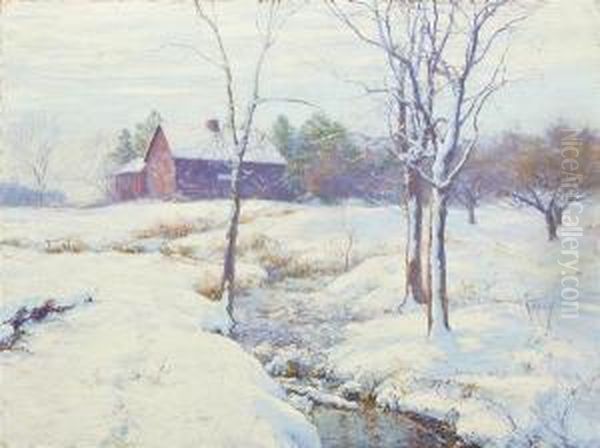
As his own style developed, he became associated with the broader movement of American Impressionism. While perhaps not as central to the core group known as "The Ten American Painters" (which included artists like Childe Hassam, J. Alden Weir, and John Henry Twachtman), Palmer shared their interest in light, color, and contemporary landscape subjects. His friendship with Twachtman, another master of subtle snow scenes, is particularly relevant, though their styles differed in handling and mood.
Palmer also collaborated or associated with other artists. Early in his career, he reportedly worked on collaborative paintings with artists like William Hart, Homer Dodge Martin, and Edward Lamson Henry (often cited as Edward Guy in some sources, potentially a confusion). His European travels connected him with figures like Robert Blum, William Merritt Chase, and Frank Duveneck, all key players in the international art scene of the late 19th century. These interactions fostered a rich exchange of ideas and techniques, contributing to the vibrant and diverse character of American art during this period. His father, Erastus Dow Palmer, remained a constant presence and supporter until his death in 1904.
Personal Life and Later Years
Walter Launt Palmer's personal life included periods of both happiness and sorrow. In 1890, he married Georgianna Myers. Tragically, she died just two years later, in 1892. This loss undoubtedly affected him deeply. Three years later, in 1895, he married again, this time to Zoe de Vautrin. This second marriage appears to have been a lasting one. Despite the information sometimes cited suggesting he remained unmarried or married much later, historical records confirm his marriage to Zoe in 1895, and they remained together until his death.
Palmer spent most of his life based in Albany, maintaining a studio there even during his periods of travel. He was a respected member of the Albany community and involved in local arts initiatives, including the Albany Institute of History & Art. His connection to his hometown remained strong throughout his life.
In his later career, during the early decades of the 20th century, the rise of Modernism began to shift artistic tastes away from Impressionism and more traditional landscape painting. While Palmer's reputation remained solid, and he continued to exhibit and receive recognition, the demand for his style may have lessened somewhat compared to its peak popularity. Nevertheless, he continued to paint actively into his later years. Walter Launt Palmer died of pneumonia in Albany on April 16, 1932, at the age of 77.
Legacy, Collections, and Market Presence
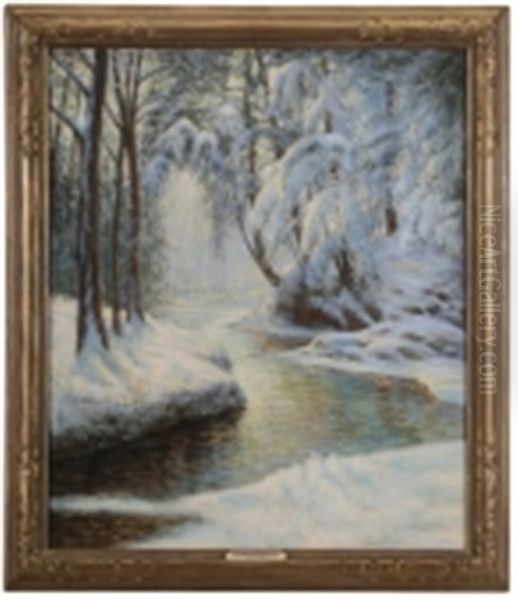
Walter Launt Palmer left behind a significant body of work and a lasting legacy as one of America's foremost painters of winter. His unique ability to capture the delicate beauty and transient light effects of snow-covered landscapes secured his place in American art history. He demonstrated that snow was not merely white but a canvas for a complex interplay of light and color, influencing subsequent generations of landscape painters.
Today, Palmer's works are held in the permanent collections of major museums across the United States. The Metropolitan Museum of Art (New York), the Museum of Fine Arts, Boston, the Smithsonian American Art Museum (Washington, D.C.), and the Butler Institute of American Art (Youngstown, Ohio) are among the prominent institutions that house his paintings. The most extensive public collection of his work, however, resides in his hometown at the Albany Institute of History & Art. This collection includes not only numerous oil paintings and watercolors but also drawings, pastels, photographs, and archival materials related to his life and career, making it an invaluable resource for scholars and admirers.
In the art market, Palmer's work continues to be sought after, particularly his signature snow scenes. His paintings appear regularly at auction, often commanding strong prices. Works like Winter Shadows fetching 2,000 at Shannon's Fine Art Auctioneers highlight the continued appreciation for his skill and vision. His Venetian scenes and other subjects also find buyers, though the winter landscapes remain his most iconic and highly valued contributions.
Conclusion: An Enduring Vision of Light and Snow
Walter Launt Palmer carved a unique niche within the landscape of American art. Born into artistry and trained by masters of both the American and European traditions, he synthesized these influences into a personal style perfectly suited to his chosen subject: the winter landscape. His paintings, especially his snow scenes, are more than mere depictions; they are poetic explorations of light, color, and atmosphere. With a palette sensitive to the subtlest shifts in hue and an eye attuned to the ephemeral beauty of dawn, dusk, and sunlight on snow, Palmer captured the quiet magic of the winter world. His legacy endures not only in the museums that collect his work and the market that values it but also in the enduring appeal of his luminous, tranquil, and masterfully rendered visions of nature. He remains a key figure for understanding the development of American Impressionism and the enduring power of landscape painting.